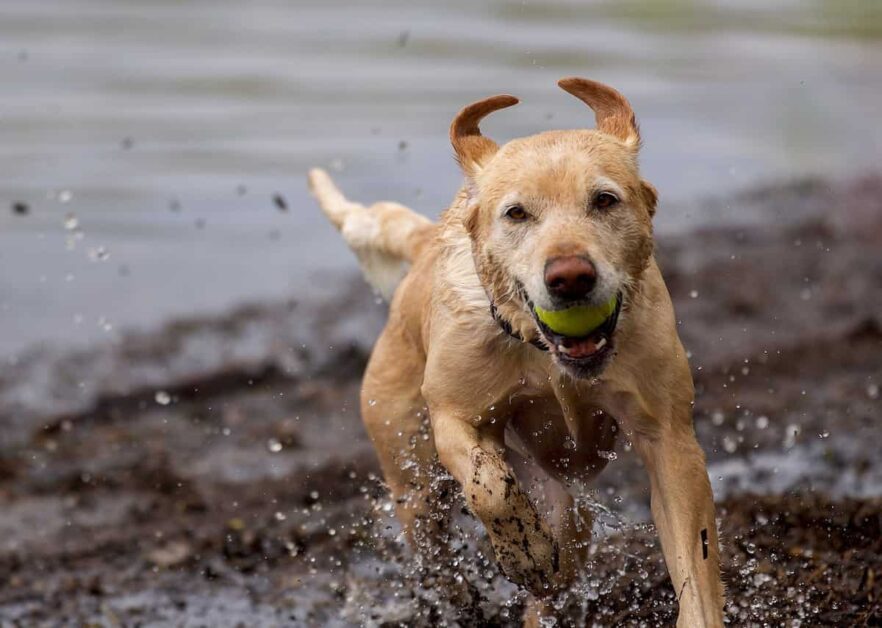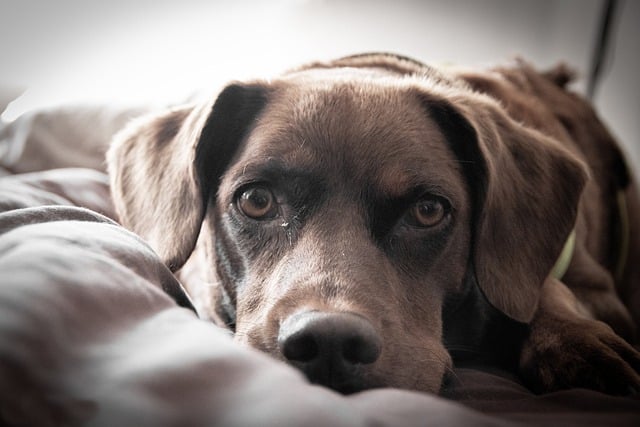Yes, Labrador Retrievers do shed, though not as heavily as some breeds. Their short, dense double coat sheds moderately year-round. More extensive “blowing” of the coat happens 1-2 times yearly. Overall, Labs require weekly brushing to control loose hair.
Their shedding can be managed through regular bathing and brushing. While Labs definitely shed, they are not considered extreme shedders. With consistent grooming, their shedding can be contained, keeping your home relatively hair-free. Lab coats and modest shedding make them a great choice for many households.
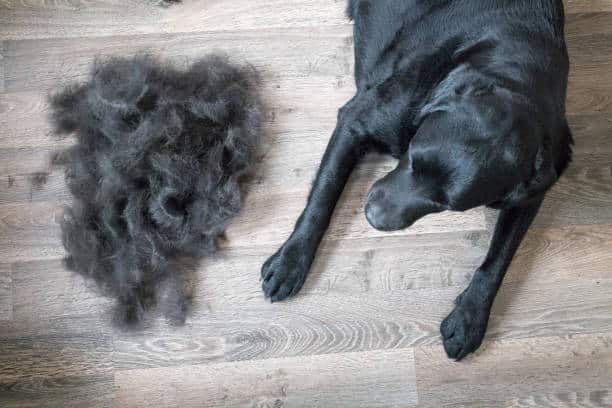
Why do labs shed so much?
Just like humans, dogs shed their excess hair throughout the year. Like other animals, the coat of the lab is essential for their survival. Having a healthy coat helps Labradors in many ways. Not only does it regulate the body’s temperature, but it also protects the skin.
People worrying about labrador shedding must know that it helps labs eliminate dead or damaged dog hair. Every dog sheds differently, depending on their breed, weather conditions, health, and other factors. Understand that shedding is natural, and all dogs experience the same. As a pet parent, you should be concerned if your lab is shedding too much.
Is Shedding a Sign of Any Health Issues?
All animals shed hair, as it is a natural phenomenon. Shedding is the body’s way of doing away with dead, old, or unwanted pet hair. Since labs have a dense double coat, shedding is comparatively higher. However, let’s now understand de shedding a labrador and how much shedding is too much.
Different factors can affect lab shedding making it difficult to know precisely when something is wrong. A good habit of understanding more about your lab shedding pattern is close monitoring. You’d need to recognize excessive shedding as there is no tangible way to answer how bad a labrador retriever sheds.
While shedding is normal and doesn’t indicate any health scare, excessive shedding warrants your lab to be taken to a vet who can analyze and prescribe a treatment.
How Often Do Labs Shed And How Much?
Labrador Retrievers top the list when it comes to shedding. Why? Because they are double coated dogs shed throughout. Their shedding is higher when the seasons start changing. For example, the shedding of labs during spring differs from what they have during the fall.
Do Labs Have Double Coats: What Is a Double Coat?
The double coat of a lab consists of the undercoat and the topcoat of their fur. The double coat is not prevalent in all breeds but are common only in a few dog breeds. Labs have had double coats for centuries as fishermen used them in Newfoundland. They were active in water and thus needed a waterproof coat layer.
Moreover, they needed an additional layer to help regulate their body temperature in cold water. And this is why they have a double coat to help them. German shepherds, Labrador retrievers, Pomeranians, Siberian Huskies, and Australian Shepherds have a double coat.
While the first layer, also known as an undercoat, has short and dense hair, the second layer, or topcoat, has longer and silkier pet hair. The undercoat is designed to keep the dog warm even when playing or swimming in cold weather. The second coat helps them keep their coat dry and free of dirt.
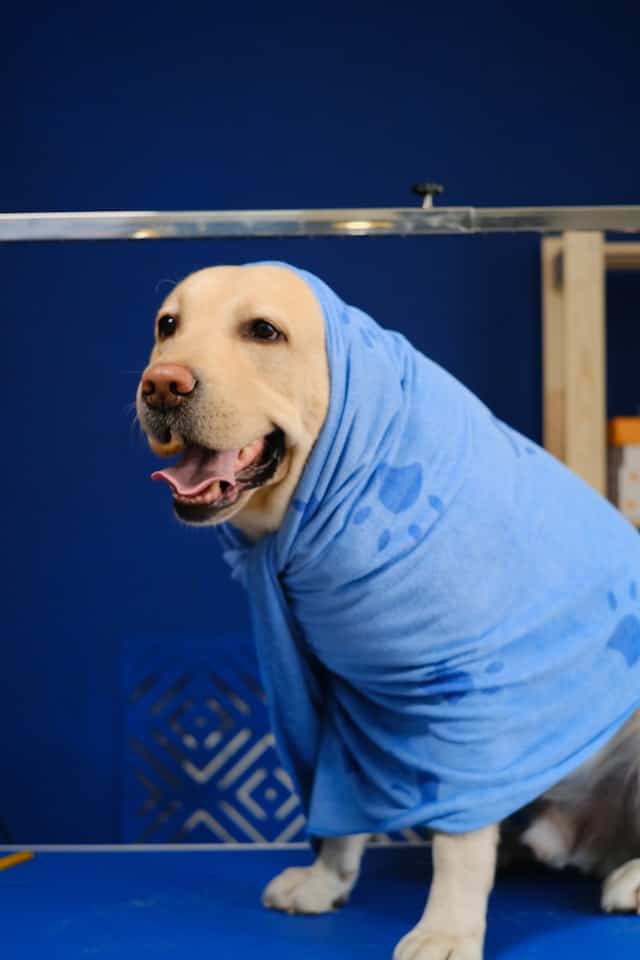
What months do labs shed the most?
Labs shed more during spring as their bodies try to do away with their dense winter thick coats. So if you are wondering when lab sheds the most, expect it between March and May- the labrador shedding season.
With time, labs again shed their summer coat after the spring season passes. They begin to bulk up again as the fall season begins. Expect excessive shedding during the start of the fall season, which is between October to December.
To make it simple, when temperatures start dropping, labs put away their summer clothing and start readying their winter gear. When summer approaches, they pack and put away their winter gear and use their summer clothing again. It is also known as “blowing coats” or the pet molting season.
How bad do labradors shed due to stress?
It is completely normal for pet parents to worry about common causes of shedding for their labs. Track the reasons behind your dog’s shedding, especially if you feel it is normal. Below are some common causes that can result in increased shedding.
1. Stress
Your pet’s hair might start thinning and fall off if continuously stressed. If your dog has excessive stress and anxiety, it can result in hair loss. Your pet can feel stressed by an environment change or when they feel bored, scared, or nervous. Labs are less prone to get stressed than other dog breeds, however.
2. Parasites
External parasites like lice, fleas, mites, and other parasites can result in extensive shedding. These parasites place themselves into your lab’s thick winter coat, resulting in scratching and hair falling off.
3. Poor diet
It is essential to provide your pet with the primary nutrients and minerals. They might have an unhealthy and thin coat when they do not have a healthy diet. It can even weaken their immune system. Lab owners must get their pet the right amount of carbs, vitamins, proteins, fats, minerals, and other elements that can benefit their health.
4. Health problems
Your dog might have an illness affecting its skin and coat. Increased shedding can result from an acute condition or other chronic illness like cancer. If you think the amount of shedding is excessive, it can have health issues as follows:
- Fungal infections
- Skin condition
- Bacterial infections
- Parasites
- Liver or kidney condition
- Allergies
- Thyroid diseases
Take your lab to the vet immediately if you notice any change in their behavior.
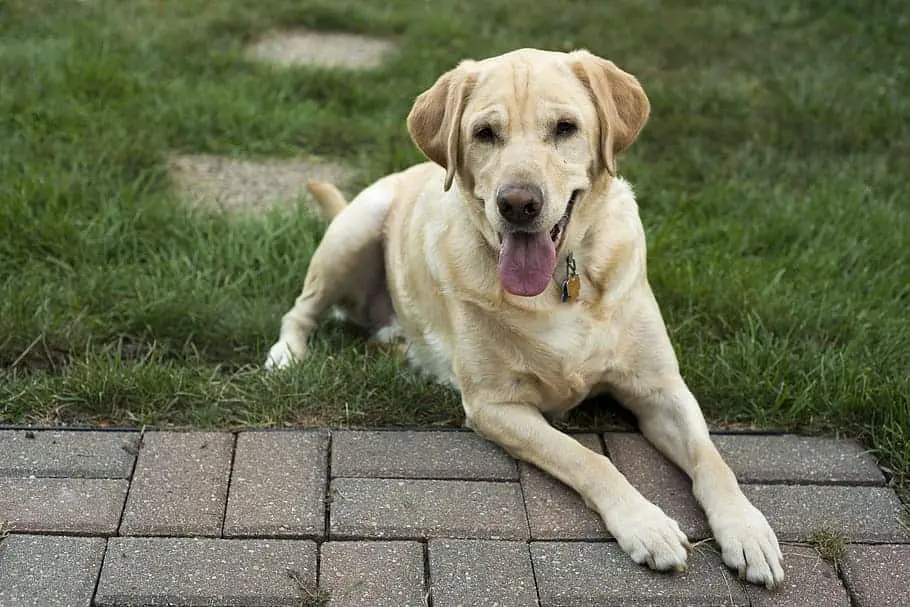
Black, Chocolate, And Yellow Lab Shedding
Do labrador retrievers shed a lot if they are of specific colors? There is a common misconception that the Lab’s color impacts its shedding frequency. However, it is wrong as all labs have the same breed and genes. Moreover, despite varied appearances, the American and English Labradors are also of the same breed.
Black, chocolate, and a yellow lab all shed the same hair. The only difference is the amount of fur you can see and notice. While dark hair is easier to notice on the ground, light hair is not.
Hence, people might feel shedding for a black or chocolate lab is more. When you have light-colored floors or furniture, you will notice the hair of black and chocolate lab hair more easily.
How To Keep Your Home Clean From Dog Hair?
Even if you monitor your dog’s shedding, you will still need to do a lot of cleaning around your house. The good news is that you can choose one of the products below for cleaning.
Robot Vacuum
A robot vacuum is one of the best products you can get for ensuring clean floors. You can map out your house in a self-cleaning cleaning bot so that it can clean specific areas.
Cordless Vacuum
You can also get a cordless vacuum to help you with general vacuuming and reach difficult areas like room corners, windowsills, etc. Being cordless makes it easy to grab it and clean the place.
Air Purifier
Getting an air purifier can be highly beneficial. It can help capture almost all airborne particles, including body odors and hair. Moreover, it will also make the house smell and look fresh.
How to Reduce Shedding In Labs: 7 Pro Tips
There are a few steps that you can take to reduce your dog’s shedding. The best way is to attack the shedding from all sides. Below is a list of seven easy steps to reduce and control your lab’s shedding.
1. Get a Labrador De-shedding Tool
One of the best ways to groom your dog is using a de-shedding tool. It is a special tool to help your lab’s coat. A de-shedding brush can work on your pet’s dense undercoat and remove loose hairs that might fall over.
It is a perfect tool to keep the thick coat shiny. Use this dog brush on your pet twice weekly. It can help by removing all the dead or loose dog hair.
2. Get a Labrador Retriever Shedding Brush
While you cannot stop shedding completely, you can groom them regularly using a Labrador shedding brush to keep their dog hair from falling everywhere. Brushing your dog twice every week will be enough. Use a slicker brush to help you remove dander and make them look smart. Moreover, it removes tangles and dirt.
3. Groom and Bathe Your Lab 3-4 Times a Year
As highlighted earlier, labs change their coat two times in one year. While taking care of your lab’s coat, using brushes does help. However, they still need further effort for perfect results. Regular baths, along with brushing your pet regularly, are an ideal combination.
You can loosen their leftover fur during bathing rather than letting the undercoat fall out automatically with time. Ensure you do not over-bathe as it might result in dry skin while removing their natural oils.
4. Switch to Food That Targets Dog’s Coat and Skin
One of the best labrador shedding solutions is getting your pet the right nutrients. Pay attention to the dog’s food you are feeding your lab. The type of food can have a significant impact on their shedding habits.
While you might think of getting inexpensive dog food like corn or grain, it might be difficult for them to digest. You should get food items that provide them with protein and other necessary nutrients. While it might cost more for commercial dog food, the amount you will spend on shedding and maintenance will be far less.
5. Keep Your Lab Hydrated
Ensuring that your lab drinks enough water daily can be highly beneficial. Dogs shed more when they are not sufficiently hydrated. Improve your dog’s health by giving them one ounce of water for each pound of their weight.
6. Stay Up-to-Date With Flea Treatment
Another critical tip for people who want to reduce shedding is to stay up-to-date with their flea treatment schedule. While flea treatment will not stop shedding, it will ensure your pet doesn’t keep scratching.
The more your dog scratches, the more discomfort they feel, and the more likely they will pull out their fur. With no fleas or ticks, they will not scratch much. Thus, the shedding will be less. It is an excellent trick for owners who need answers on reducing shedding.
7. Include Omega Fatty Acids in Your Lab’s Diet
The instances are high when you think about the amount of shedding without a proper diet. Add omega fatty acids to their regular diet to improve the health of their hair. Add specific dog food into their meals containing omega-3 fatty acids and supplements containing these nutrients. If your pet doesn’t consume much oil, you can add olive oil to their diet.
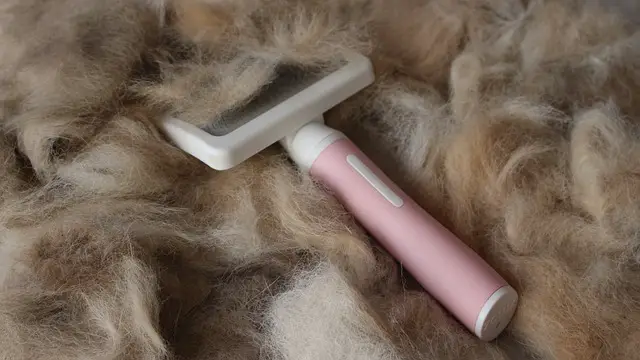
FAQs
Do Labrador Shed A Lot, And How Do I Stop My Lab From Shedding?
All labs shed, and you can do nothing to stop the shedding completely. It is natural for labs to shed. Reduce the shedding amount by following the tips mentioned above.
Do Labradors Have An Undercoat, And Does Labrador Retriever Shedding Smell?
All labs have an undercoat, and they shed throughout the year, and even during mounting, they produce an odor. Groom them regularly to keep them fresh.
Do black labs shed? do chocolate labs shed
All labs share the same genetic makeup, history and historical background. Labradors and golden retrievers shed a lot of loose hair and dead hair during labrador shedding season
Which Labradors Shed The Least?
New pet parents often wonder whether golden retrievers or chocolate labs shed the least. The truth is the shedding of labs depends on the care and diet they receive. Without proper grooming and nutrients, any lab can shed more.
How to stop a lab from shedding?
All dogs, like humans, shed their hair, which is a part of their life cycle. They shed hair during different seasons that grow back later, making them look prettier. While you cannot overcome it, you can manage it through proper grooming.
How Can I Manage Excessive Dog Hair?
To reduce shedding, you have to take proper care of your pet while grooming them, and you can choose to follow the tips discussed in this article. Moreover, you can get a vacuum cleaner or other devices to keep your house clean.
Do Labradors Shed Less In Tropical Weather?
Labs shed more during season changes. During the onset of spring and fall, they tend to lose their old coat and grow new coats to suit the weather.
Do yellow labs shed?
Yellow labs are double-coated dogs and shed year-round, but they shed the most in the spring and fall.
Do chocolate labs shed?
Yes, chocolate labs are double-coated dogs and shed year-round, but they shed the most in the spring and fall. Labs of all colors shed.
When do labs shed their winter coat?
Labs shed their winter coat in the spring and fall.
Do golden labradors shed?
Yes, golden labradors are also double-coated dogs and shed year-round, but they shed the most in the spring and fall.
What is the best way to deshed a lab?
The best way to deshed a lab is to brush them regularly with a deshedding tool. You can also bathe them with a deshedding shampoo.
Do labradors molt?
Yes, labradors molt. Molting is the process of shedding old hair and growing new hair.
Can I shave my lab?
You can shave your lab, but it may make them more susceptible to sunburn and other skin problems. We’d recommend avoiding shaving unless it is an emergency.
How often should a lab be groomed?
Labs should be groomed at least once a month. This includes brushing, bathing, and trimming their nails.
Should labs get haircuts?
Labs do not need haircuts. Their fur is designed to keep them cool in the summer and warm in the winter. However, you may want to trim their nails regularly to prevent them from becoming overgrown.
Do golden retrievers shed more than labs?
No, golden retrievers and labradors shed about the same amount. However, golden retrievers have a slightly longer coat than Labradors, so they may seem to shed more.
Author Profile
- Site Owner And Planning Specialist
-
Aritra, the founder of Labradorandyou.com, is a lifelong dog lover whose passion ignited for Labradors for their loyalty and intelligence. With extensive research and personal experiences, Aritra has become a Labrador expert, offering a rich resource on the breed. Labradorandyou.com provides reliable, timely, and evidence-based information, including Labrador-specific product reviews, training techniques, and care tips.
Labradorandyou.com was born out of Aritra's passion and his desire to share his profound knowledge about the breed. The site serves as a comprehensive resource, offering a wealth of up-to-date information for Labrador owners and enthusiasts alike
Also by the author
 FAQNovember 17, 2023How To Adopt An Emotional Support Dog?
FAQNovember 17, 2023How To Adopt An Emotional Support Dog?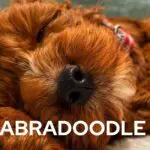 Mix-BreedsNovember 16, 2023Red Labradoodle Ultimate Guide: Breed Facts, Care Tips
Mix-BreedsNovember 16, 2023Red Labradoodle Ultimate Guide: Breed Facts, Care Tips Top BreedersNovember 8, 2023Breeding Labradors: Everything You Need to Know
Top BreedersNovember 8, 2023Breeding Labradors: Everything You Need to Know FAQOctober 17, 2023Do Dogs Like Music? Researchers Say Yes! Find Out
FAQOctober 17, 2023Do Dogs Like Music? Researchers Say Yes! Find Out
